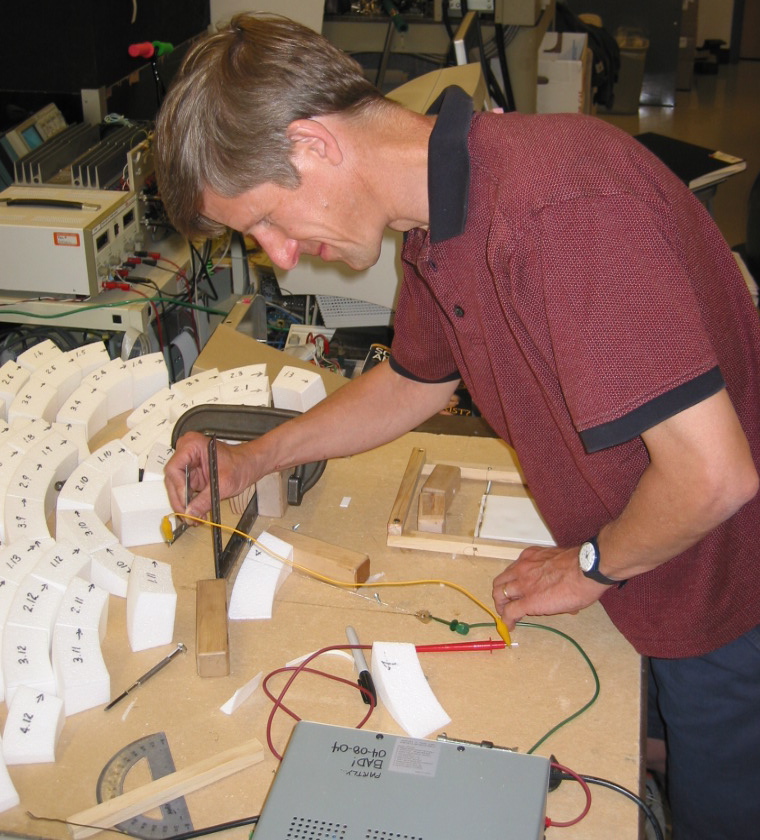- The shape of the stones matters. (Voussoirs)
- How can we find a material that can easily be cut into the right shape? (l'arco romano di formaggio)
- Then we can experiment with "scaffolding" and see how surprisingly stable the final product is
Domes
http://scholar.google.com/url?sa=U&q=http://www.graphics.cornell.edu/~moreno/download/MA_MAPiccolotto.pdf -- thesis on florence and michelangelo dome etc. origins st. peters basilica- paper on masonry dome stress analysis Univ. of Bath.
- interesting review of benchmark book on historical building analysis. Discusses general problems.
Random links
A bit of philosophy
- Nice passage from Umberto Eco, "The Island from the Day Before" (l'Isola del Giorno Prima), Harcourt Brace, 1995, on the philosophy of a stone that finds itself assembled into a wall or a dome.
Strength and stability of arches
Notes regarding masonry arch and dome construction and analysis- paper comparing modern beam and hinge methods from dur.ac.uk
- Some software for arches: http://www.shef.ac.uk/ring/index.html
- Install program for the software (Windows PC) and manual (PDF are attached at bottom of page.
- Sample screen from program for case of 25KN (about 2.5 tons) vehicle on thin single arch 5m long
LABOUR-BASED TECHNOLOGIES AND METHODS FOR EMPLOYEMENT INTENSIVE CONSTRUCTION WORKS BEST PRACTICE GUIDELINE 4-3: Rubble Masonry Concrete Arch Bridge Construction Technology April 2004. First edition of CIDB document 1028 -- South Africa & Zimbabwe
Masonry Arch Bridge construction first appeared in ancient civilisation in Mesopotamia between the Tigris and Euphrates Rivers, some 3000 years ago. The oldest surviving masonry arch bridge is at Smyrna, in Turkey. It was built around 900 BC. Numerous masonry arch bridges have subsequently been constructed, all around the world. (See Figure 3.1). As the construction technology developed, b ridges started to show evidence of an effort to shape and fit the stones to minimise the joint thickness between them and to orientate the stones so that the principal stresses would be at right angles to the joints. This showed an inherent comprehension of the basics of arch action.
This is easily achieved in arches that carry either a pure uniformly distributed load or a pure point load. In the former case, for example, where the arch is required only to support its own weight, it would always meet these conditions, provided it approximated the shape of an inverted catenary. The inverted catenary arch perfectly traces its line of self-weight-induces thrust, just as a chain sags reciprocally in perfect tension. In the latter case, where the arch has only to support a point load, it would qualify for these conditions if it had a triangular shape whose apex coincided with the load. However, upon the application of point loads to catenary arch, tensions quickly develop. Where the point load is static, such tensions can easily be alleviated by distorting the catenary arch shape towards that of a triangle. However, when the point load may be dynamic, as is always the case in bridges, the solution is rather more complex since the arch ring must be capable of accommodating each unique shape of line thrust as the load moves across its deck. This is achieved in practice by thickening the arch ring, by increasing the dead-weight of the structure itself, and/or by tolerating a small amount of tension within the arch. It is generally assumed that the material is infinitely strong in compression and that, provided the reaction to thrust is maintained, a failure condition is reached when the line of thrust reaches the outer faces of the masonry at no fewer than four points, converting the structure into a kinematic mechanism by the formation of hinge points where the line of thrust alternately coincides with the intrados and extrados of the arch.
Cutting foam for a model of the cupola a Firenze
- cutting foam with hot wire:

Ideas, requests, problems regarding TWiki? Send feedback